full article:
Chronic illnesses affect nearly half of all adults in the USA today1,2. Projections indicate that half the population will live with one or more chronic diseases by the year 20301,2. Chronic illnesses account for 70% of all deaths1. Heart disease and stroke are the major causes1. Diabetes increases the risk of heart disease, stroke, kidney failure, and blindness, among other morbidity. However, the risk of acquiring a chronic disease, such as diabetes, and subsequent morbidity and/or disability, can be decreased by modifying health behaviors.
This study was undertaken to promote health and improve overall wellness through patient education. 'Health promotion is the process of enabling people to increase control over and to improve their health'3. Health promotion efforts seek to empower individuals to optimize their health and the quality of their life through self-care rather than remaining in the more traditional biomedical model that emphasizes the physician's responsibility to treat disease4. Healthy People 2010 recommends that high-quality information and support services be developed for specific health problems and health-related decisions that are culturally sensitive and appropriate for various educational levels5. Healthcare professionals need to consider multiple social, biological, cultural, and economic factors that influence health and health behavior when planning interventions5. These new health behaviors may improve wellness while conserving healthcare resources.
'Wellness' is a broad concept that includes more elements than the conventional definition of health. If one defines health as merely the absence of disease, the results of objective data determine whether the patient is free of disease and thereby healthy. Wellness utilizes more subjective criteria than either the presence or absence of disease. The process relies on the individual's perception of the seven dimensions of wellness6-8:
- physical
- social
- psychological
- intellectual
- economic
- environmental
- spiritual.
Wellness suggests that an individual has attained the full potential of health and wellbeing6-8. The concept of wellness is a continuous process where individuals move back and forth from lesser to greater states of wellness as they learn and apply knowledge to achieve a balanced and healthy lifestyle8. Knowledge may include gaining information on their disease state as well as implementing the skills required to successfully manage their chronic disease.
To facilitate these self-management behaviors, individuals should have access to current, evidence-based information that they can understand in order to adopt healthy behaviors9. Information and communications technologies are resources to provide the information to the public in order to generate behavioral changes. Physicians' offices are a logical setting for providing this information. However, the delivery of quality, specialty healthcare services to rural populations can be a difficult and challenging process. Many residents live in areas that do not have access to health care or health and wellness education services. Also, rural health clinics lack the financial resources to provide commercially available patient education materials. These clinics rely on pamphlets from pharmaceutical companies to give their patients health information. The information contained in these handouts may be commercially biased or become outdated by the time the last pamphlet is distributed.
A wealth of current, evidence-based information is available from internet sources, but this is often difficult for individuals to locate. Using the latest technologies, information can be readily available for healthcare providers and the general public if they are able to locate it.
Evidence-based information that can be easily located by rural healthcare providers and their patients could be utilized to promote health and wellness, thereby resulting in improved disease management and quality of life (QOL).
The Pew Research Center (2009) and Reuters (2010) reported that the majority of adults used the internet as a source of health information10,11. With health information available through technology, people can obtain the most current data to educate themselves and manage their illness. However, many sites contain information that is not evidence-based, or may be biased due to advertising by their sponsors.
Nicholas et al (2001) reported that the internet was the second most consulted information source, next to the physician12. Whereas, the Pew Research Center reported that individuals consulted the internet (57%) after consulting their physician (86%), family member, or friend (68%)10. The majority of respondents (42.5%) visited a health education site looking for information to help them remain healthy, with a relatively high proportion of those visitors (61%) reporting that their health had improved12. Most importantly, when respondents rated the site's authenticity as being high, the greater the benefit reported by the respondent12. In order to assist patients in locating accurate healthcare education and social services via the internet, a web site, My Health Education & Resources Online (MyHERO), was created to act as a portal to current, reliable information. This site remains available to anyone with internet access.
The authors hypothesized that individuals who receive relevant, current, evidence-based health education will result in the following to successfully manage their chronic disease:
- greater disease knowledge
- improved QOL
- development of healthy behaviors.
Relevant health information can be provided from either a nurse educator or through the internet. However, individuals receiving one-on-one health education and instructions to navigate the web portal may show greater changes over individuals provided traditional patient instructions consisting of verbal instruction and printed material. This report addresses the findings of this study.
A convenience sample of 98 participants from two rural medical clinics was recruited by word-of-mouth and recruitment flyers for this study. The target population was adults (aged ≥18 years) with a medical diagnosis of type 2 diabetes. Exclusion criteria included pregnancy, being less than 18 years of age, unable to give consent, and unable to speak or read English. These criteria had the potential to introduce confounding variables to the study. The Institutional Review Boards at Saint Francis University and the Telemedicine and Advanced Technology Research Center approved the research protocol. Prior to participation, each subject read and signed an informed consent form.
Description of intervention
A nurse educator was appointed to the intervention clinic site. The second site served as the control. Participants from both sites received traditional patient instructions: verbal and/or written instructions given by the provider, an instructional handout that included step-by-step instructions and computer screen shots explaining how to access the MyHERO web portal, and web addresses of all the web links.
In addition to these traditional patient instructions, participants from the intervention site (n=48) received one-on-one healthcare education and hands-on instruction from a nurse educator on how to access and navigate MyHERO.
Selected patient education for the intervention group included topics requested by the patient, and nurse educator assessment. The nurse educator documented these topics on an educational needs assessment form based on the Indian Health Services diabetes patient education protocols13. Education sessions took place in the office or via telephone approximately every 6 weeks. The nurse educator provided in-person education in the office if the participant had a scheduled visit within the prescribed timeframe. Otherwise, she phoned the participant to provide the education and follow up. If the nurse educator was unable to contact the participant after three phone attempts, she attempted again in 6 weeks. Control group participants had no follow up by the research staff. All participants were asked to complete baseline and 6-month follow-up surveys to measure disease knowledge and QOL.
Equipment
An internet-ready laptop was provided to both clinics. MyHERO was designated as the internet homepage when opening the web browser. Patients were able to access the laptop any time during clinic hours. Patients could also access the MyHERO portal from any computer connected to the internet. Patients without internet access in their homes were informed of public venues where they could access the internet (eg public library) if they desired.
Data collection Instruments
The pre/post knowledge test format of the BASICS curriculum (The International Diabetes Center, St. Louis Park, MN) specifically measures the progression of knowledge as a patient moves through four sessions of the curriculum14. BASICS is an evidence-based education program developed to prepare people with diabetes to make self-management decisions on their own. Increased diabetes disease knowledge can result in the reduction of hemoglobin A1c (HbA1c) and body weight in people with type 2 diabetes14. The test measures knowledge by asking 15 multiple-choice questions in the following content areas:
- general diabetes
- nutrition
- physical activity
- treatment
- acute complications
- chronic complications
- psychosocial aspects.
Content validity ranged from 0.82 to 1.00 with an overall Cronbach's α of 0.72. Reliability scores ranged from 51.2 to 97.715. Participants completed the paper and pencil version of the Type 2 Diabetes BASICS Pre/Post Knowledge Test (2nd edn).
The assessment of disease related QOL was measured by the Problem Areas In Diabetes (PAID) questionnaire (Joslin Diabetes Center; Boston, MA, USA). The PAID contains 20 questions that measure current diabetes-specific emotional distress related to living with diabetes and its treatment. This questionnaire has high internal reliability, test-retest reliability, and is a statistically significant predictor of glycemic control16. The PAID also correlates well with a wide range of theoretically related constructs such as depression, general emotional distress, diabetes self-care behaviors, diabetes coping, and health beliefs15. Participants rated the degree to which a situation is a problem on a six-point scale. Higher PAID scores indicate more diabetes-specific emotional distress.
In addition to these surveys, all participants were given a behavior survey to assess whether they changed any self-management techniques as a result of their participation in the study. The behavior survey consisted of 5 diabetes-related behavior questions rated on a seven-point Likert scale (0-6). Participants rate '0' for no change and '6' for always compliant.
Participants in the intervention group were given a satisfaction survey at the conclusion of the data collection to assess the education provided by the nurse educator and MyHERO. The survey consisted of 11 questions rated on a five-point Likert scale (Strongly Agree, Agree, Don't Know, Disagree, and Strongly Disagree). There were two additional questions requiring a free-text response, an area for suggestions, and an area for additional comments.
Demographic and clinical data were collected by medical record review at baseline, 3 months, and 6 months on all participants. Clinical data included: height, weight, vital signs, serum glucose, HbA1c, and lipid panel. Data were entered into a Microsoft Excel spreadsheet and Access database software.
Qualitative data were collected from the nurse educator in the form of a satisfaction survey. The survey included questions about the web portal, ease of use, technical support, and anecdotal feedback from the intervention participants.
Statistical analyses were performed using SAS software v 9.2 (www.sas.com) and Microsoft Excel. There were no demographic differences between the control and intervention groups. Baseline clinical data and survey scores were similar between the groups (Table 1).
Table 1: Baseline demographics and survey scores
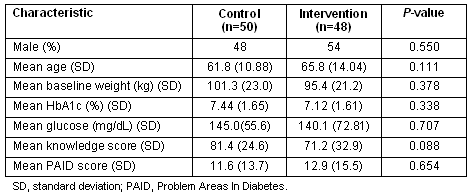
Statistical comparisons were performed to test the difference between the two groups in various outcome measurements and over time (baseline, 3 months, and 6 months). A χ2 test was used for testing differences between the two groups in categorical baseline and demographic factors and attrition rates between groups. Analysis of covariance (ANCOVA) was used to test continuous outcomes for difference between the two groups, over time and interactions between group and time. Pearson correlation analysis was performed among baseline factors and with various outcome measurements. Statistical significance is evaluated at α of 0.05 and no multiple comparison adjustment for α was performed.
Fifty-four subjects participated for the length of the 6 month study with 53 full completions. One subject refused to complete one or more surveys at the end of the study period. Medical record review was completed on all participant charts at 3 and 6 months; however, many data points were missing from the medical record. The study was designed to collect only the data that was available on the patient chart so as not to incur additional charges to the patient or third-party payer due to extra testing.
Attrition in both groups was high. The control group had higher attrition rate than the intervention group (31 and 13, respectively) despite multiple attempts from the clinic staff and the nurse educator to encourage participants to complete the 6 month surveys. Comparisons using χ2 analysis were made on the basis of sex, study site and completion status to determine inherent differences in participant groups (Tables 2-4). Among participants who did not complete the study, there was no significant difference between genders when analyzed by study site (Table 2). However, there is a statistically significant difference in groups when analyzing attrition by study location (Table 3). On further examination, there is a statistically significant difference when analyzing sex and study site compared with completion status (Table 4).
Table 2: Participants lost through attrition: sex by study group

Table 3: Total participants: completion status by study group

Table 4: Participants' sex and study group by completion status

Clinical measurements
There were no significant differences between the two groups over time in vital sign measurements including systolic and diastolic blood pressure and heart and respiratory rates. The aggregate clinical data and survey scores at 6 months are shown (Table 5). Weight differences were not significant between the two groups over time. The height of the patient was missing from many patient charts (36% control; 100% intervention) although the staff stated that the office policy was to obtain this measurement at least annually. Without this measurement, the authors were unable to compare BMI between groups.
No significant differences or changes were observed for lipid levels. There was a significant difference in glucose levels between groups at 6 months (p=0.008). The intervention group showed a trend toward lowered serum glucose levels from baseline to month 6 when adjusted for time (p=0.201).
Table 5: Six-month clinical data and survey scores

Knowledge measurement
The BASICS Diabetes Knowledge Test scores showed a significant increase in the intervention group (mean increase of 26.6 points; p=0.001) from baseline to month 6 (Table 6). An increase in knowledge test scores reflected a higher proportion of correct responses indicating an increase in disease knowledge. No differences were observed in PAID scores from baseline to month 6 (Table 7).
Table 6: BASICS diabetes knowledge pre- and post-test scores
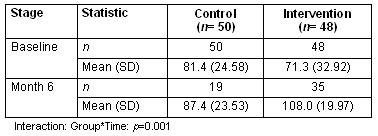
Table 7: Problem Areas In Diabetes (PAID) survey scores
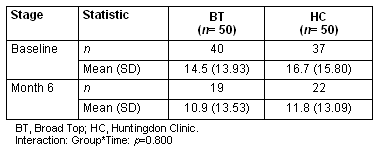
Behavior change
Self-reported behavior change measurements from baseline to month 6 did not show significant differences in eating habits, medication compliance, physical activity, weight, or feet check. However, there was a larger increase in the intervention group (mean=1.3, 95% CI: 0.78-1.85) in self-blood glucose monitoring than in the control group (mean=0.1, 95% CI: -0.04-0.23; p<0.001).
Participant satisfaction
A total of 34 of 35 participants from the intervention site fully completed the satisfaction survey. Overall, these participants responded positively to the individualized education provided by the nurse educator and did not prefer receiving information from the internet (Fig1).
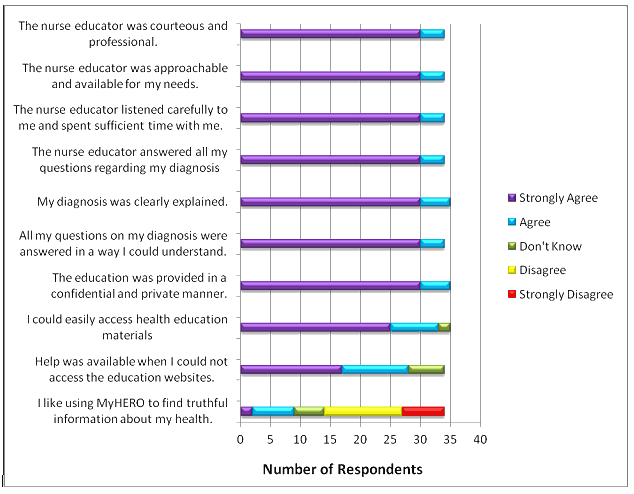
Figure 1: Participant satisfaction survey.
Web usage
The authors tracked web usage monthly to monitor the frequency of use for each web link (Fig2). MyHERO usage was highest at the beginning of the study and declined to the end of the calendar year. Usage increased in January and this may have been due to the authors' discussion with the nurse educator about declining MyHERO use. However, overall usage declined throughout the study. The MyHERO home page was viewed most frequently, followed by the Diabetes links. The Helpful Links, Healthy Living, and Heart Disease pages were the most infrequently viewed pages.
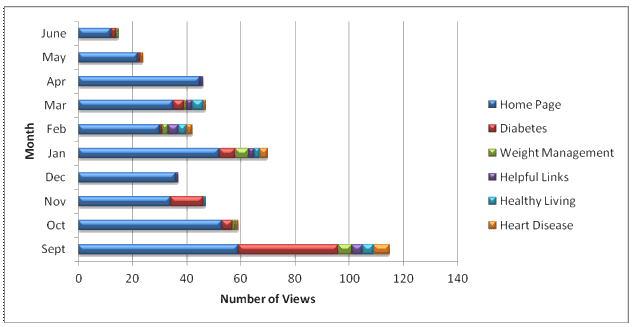
Figure 2: MyHERO usage by month.
Discussion
This short study suggests that information provided by a nurse educator and/or through an internet portal (MyHERO) may increase diabetes-related knowledge, improve blood glucose control and self-blood-glucose monitoring behavior. It appears that the participants were receptive and were willing to change their blood glucose monitoring habits. However, it is not clear if this knowledge is transient or requires reinforcement to help these individuals maintain their behavioral change. A longer study period is needed to assess whether the improvements would lead to an increase in diabetes-specific QOL scores.
As a whole, the participants in the intervention group responded more favorably to the patient education provided by the nurse educator. The authors speculate that the negative responses to the internet portal were due, in part, to the mean age of the participants at the intervention site (65.8 years). The Pew Research Center reports that adults aged over 50 years are less likely to utilize information technology to locate health information and only '42% of wired seniors look for specific medical treatment information online'10. Anecdotal responses from the nurse educator confirmed this statement. However, information on this variable was not collected through the participant surveys.
The nurse educator also stated that many participants reported they did not have an internet connection in their home. Internet penetration in US rural areas (75%) continues to lag behind urban areas (89%)17. Approximately 21% of the US population resides in a rural area18. Rural areas also have a higher proportion of older adults and persons with disabilities18-20.
The most current statistics indicate that only 40% of individuals over the age of 65 years access the internet, and only 29% seek health information21. The younger patients indicated to the nurse educator that they were more likely to have internet access in the privacy of their home and would be receptive to and less suspicious of information from the internet. Those who did not have internet access informed the nurse educator that they were reluctant to utilize the internet in public locations (eg library) because they were not accustomed to visiting those venues.
Anecdotal comments from the clinic staff and the nurse educator revealed that participants did not utilize the laptop computer in the clinic. This may have been due to the location of the laptop in a re-purposed examination room in the clinic. The laptop was intentionally placed in an area that offered privacy so that participants could access information they may have been reluctant to access in a public area (the waiting room). Perhaps internet-ready kiosks available in the waiting area or areas frequented by the public (eg grocery stores, malls, beauty salons, churches) would encourage usage. In addition, frequent reminders from the physicians may increase the traffic to these sites.
Limitations
High attrition, self-reported surveys, and a relatively short data collection period were the limitations of this study. A longer study period is needed to observe any significant changes in laboratory values or clinical measures and to measure retention of knowledge and behaviors. However, significant increases in disease knowledge and self-blood glucose monitoring behavior were seen in the intervention group, along with a trend in decreasing serum glucose values. Applying the methodology to patients with chronic disease states other than type 2 diabetes could also yield different results.
Our exploratory study was conducted to gauge the efficacy as well as the acceptance of internet-based health education within a rural US population, and its usefulness in terms of behavioral changes. Although important insight was gained, future studies with a younger patient population, a longer data collection period, or with more widespread publically accessible internet portals may yield statistically significant results in self-management behaviors, QOL measures, and clinical data.
Acknowledgements
This project was supported by Saint Francis University's Center of Excellence for Remote and Medically Under-Served Areas (CERMUSA) in Loretto, Pennsylvania, USA, and funded by the US Army Medical Research and Materiel Command (USAMRMC) Telemedicine and Advanced Technology Research Center (TATRC), Fort Detrick, Maryland (Contract Number W81XWH-06-2-0018). The authors gratefully acknowledge the following people: Dr Tiepu Liu, biostatistician, for analyzing the data collected in this study; Ms Lori McClellan, health research communications specialist, for her assistance with proofreading and formatting the figures in this submission; and Ms Leigh Montecalvo, nurse educator, who provided the individualized patient education at the intervention site. Also thanked are all the staff of the Broad Top Area Medical Center for their assistance with this project; specifically Dr James Hayden, medical director, Mr Gary Sauers, administrator, Ms Geri Angelo, X-ray technician, Ms Dorcas McCahan, phlebotomist, and Ms Kathy Myers, office manager.
References
1. Centers for Disease Control and Prevention. Chronic diseases and health promotion. (Online) 2009. Available: http://www.cdc.gov/chronicdisease/overview/index.htm (Accessed 2 November 2010).
2. Robert Wood Johnson Foundation. Chronic care: making the case for ongoing care. (Online) 2010. Available: http://www.rwjf.org/files/research/50968chronic.care.chartbook.pdf (Accessed 24 February 2011).
3. World Health Organization. Health promotion glossary (WHO/HPR/HEP/98.1). Geneva: WHO. (Online) 1998. Available: http://www.who.int/hpr/NPH/docs/hp_glossary_en.pdf (Accessed 9 November 2010).
4. Parker MW. Soldier and family wellness across the life course: a developmental model of successful aging, spirituality, and health promotion. Part I. Military Medicine. (Online) 2001. Available: http://findarticles.com/p/articles/mi_qa3912/is_/ai_n8963231?tag=artBody;col1 (Accessed 4 June 2008).
5. US Department of Health & Human Services, HealthyPeople.gov. With understanding and improving health and objectives for improving health. (Online) 2000. Available: http://www.healthypeople.gov/document/html/volume1/11healthcom.htm (Accessed 13 September 2008).
6. Caribbean Private Sector Response to Chronic Diseases. What is health and wellness. (Online) 2007. Available: http://www.paho.org/English/AD/dpc/nc/7-dimensions-wellness.pdf (Accessed 2 November 2010).
7. Kiefer RA. An integrative review of the concept of well-being. Holistic Nursing Practice 2008; 22(5): 244-252.
8. Smith BJ, Tang KC, Nutbeam D. WHO health promotion glossary: new terms. (Online) 2006. Available: http://www.who.int/healthpromotion/about/HP%20Glossay%20in%20HPI.pdf (Accessed 9 November 2010).
9. Suter, PM, Suter WN. Timeless principles of learning: a solid foundation for enhancing chronic disease self-management. Home Healthcare Nurse 2008; 26(2): 82-88.
10. Fox S, Jones S. The social life of health information. (Online) 2009. Available: http://www.pewinternet.org/~/media//Files/Reports/2009/PIP_Health_2009.pdf (Accessed 3 March 2011).
11. Reuters. More than half of Americans use internet for health. (Online) 2010. Available: http://www.reuters.com/article/idUSTRE6120HM20100203 (Accessed 1 November 2010).
12. Nicholas D, Huntingdon P, Williams P, Blackburn P. Digital health information provision and health outcomes. Journal of Information Science 2001; 27(4): 265-276.
13. Indian Health Service. Documenting patient education, vol1. Rockville, MD: HIS, 2008.
14. Powers MA, Carstensen K, Colón K, Rickheim P, Bergenstal RM. Diabetes BASICS: education, innovation, revolution. Diabetes Spectrum 2006; 19(2): 90-98.
15. Rudolph L. Validity and reliability study of the diabetes information test given to patients at the International Diabetes Center. Thesis. Menomonie, WI: University of Wisconsin-Stout. (Online) 1998. Available: http://www.uwstout.edu/lib/thesis/1998/1998rudolphl.pdf (Accessed 3 May 2011).
16. Welch G, Weinger K. Anderson B, Polonsky WH. Responsiveness of the problem areas in diabetes (PAID) questionnaire. Diabetic Medicine 2003; 20(1): 69-72.
17. Internet World Stats. Broadband adoption increases in rural America but remains below overall US level. (Online) 2011. Available: http://www.internetworldstats.com/am/us.htm (Accessed 23 February 2011).
18. US Census Bureau. United States - urban/rural and inside/outside metropolitan area. (Online) 2000. Available: http://factfinder.census.gov/servlet/GCTTable?_bm=y&-geo_id=01000US&-_box_head_nbr=GCT-P1&-ds_name=DEC_2000_SF1_U&-format=US-1 (Accessed 23 February 2011).
19. Agency for Health Care Policy and Research. Improving health care for rural populations. Research in action fact sheet. Rockville, MD: AHCPR Publication No. 96-P040. (Online) 1996. Available: http://www.ahrq.gov/research/rural.htm (Accessed 17 March 2011).
20. US Department of Transportation. Census 2000 population statistics. (Online) 2004. Available: http://www.fhwa.dot.gov/planning/census/cps2k.htm (Accessed 23 February 2011).
21. Dolan PL. New vital sign: degree of patient's online access. Amednews.com. (Online) 2011. Available: http://www.ama-assn.org/amednews/2011/02/21/bil20221.htm (Accessed 23 February 2011).
